|
The Sea Chest |

|
Whenever I publish an article, or book for that matter,
I always hope that readers will not only find it interesting
but useful. So I was very pleased when I heard from
a reader who had used the information he found in
an article
I wrote on the Sliding Gunter sail for the November
2004 issue of Duckworks.
The reader, Yorgos Papatheodorou, had built, as
his first project, an 11 foot 6 inch sailboat from
a set of 40 year old plans. After several attempts
to modify the original Gaff sail he was still not
happy with the resulting Bermudian sail. The mast
was too tall, the sail had no way to be reefed and
according to Yorgos was “downright dangerous”
if the wind kicked up. But after reading the article
in Duckworks he “modified some of the existing
pieces for a Sliding Gunter.”
The first step was to modify the original Gaff yard
into the Gunter yard. In the article I mentioned that
it could be as simple “as a square piece of
light-weight wood, with or without a taper”
and that is the way Yorgos made his yard.
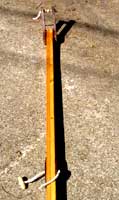
Figure 1 |
Figure
1 shows that the square yard
was laminated from what appears to be
White Pine. Nothing exotic just what you’d
find at the any big chain lumber yard
like Home Depot or Lowes. In fact everything
he used in the entire project including
white pine, ½ plywood, rope, and
fair leads can be found at the local store.
(click
images to enlarge) |
|
He made the jaws of the Gunter yard from ½
plywood and used wooden beads and rope to make the
parrels.
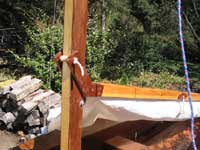
Figure 2 (above)
Figure 3 (right) |
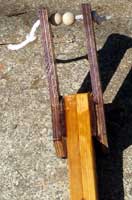
|
|
| If you compare
the jaws on Yorgos’ yard (Figure
2, Figure 3) to
the jaws of the Drascome Longboat in the
article (Figure 4) you
can see he was heavily influenced by the
Longboat jaws. |
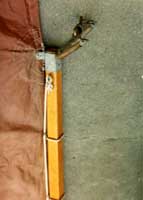
Figure 4
|
|
He could have just as easily used a toggle or roband
but the jaws matched up nicely with the square mast
as Figure 2 indicates.
Another good match is the top of the yard to the
mast and it’s one of the features I like best
about the rig Yorgos designed.
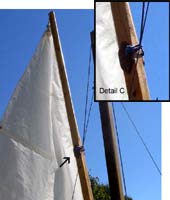
Figure 5 |
If you
look closely at Figure 5
and Detail 5 you can
see that the halyard is made fast to the
yard with a loop and then fed though the
top of the mast. As a result the yard
matches up with the mast.
|
|
| Compare this
to the system in the article (Figure
6) where the halyard has a snap
clip that attaches to the yard. Even with
the halyard hauled tight the yard doesn’t
lie next to mast because the clip acts as
a spacer. |
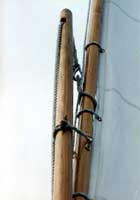
Figure 6
|
|

Figure 7 |
But with
the system Yorgos devised, the yard lies
right next to the mast (Figure
7). |
|
| Even when
the sail is reefed the mast and yard match
well. Figure 8 show the
sail with a reef taken. |

Figure 8
|
|
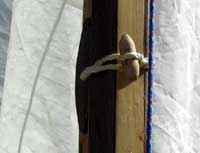
Figure 9 |
The toggle
shown in Figure 7 and
close-up Figure 9 help
the yard lie close to the mast as the
halyard is eased to take a reef. |
|
It is possible to reef without this toggle but the
yard will tend to flail about without the yard secured
to the mast in some fashion.
Yorgos had to learn to make an eye splice in order
to put together the toggle but he feels that making
an eye splice is a good skill to have and I couldn’t
agree more. It was marlinspike skills (making the
eye splice and other running rigging) along with some
careful thought that turned a “downright dangerous”
boat into one that is a pleasure to sail.
| According
to Yorgos (Figure 10) he
gets “a lot of questions and compliments
on the old-timey rig, which is brilliant
in its simplicity and functionality.” |
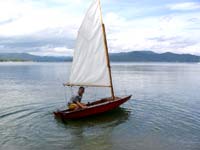
Figure 10
|
|
I think “brilliant in its simplicity and functionality”
really sums up not only the Sliding Gunter but all
traditional sails as well.
|